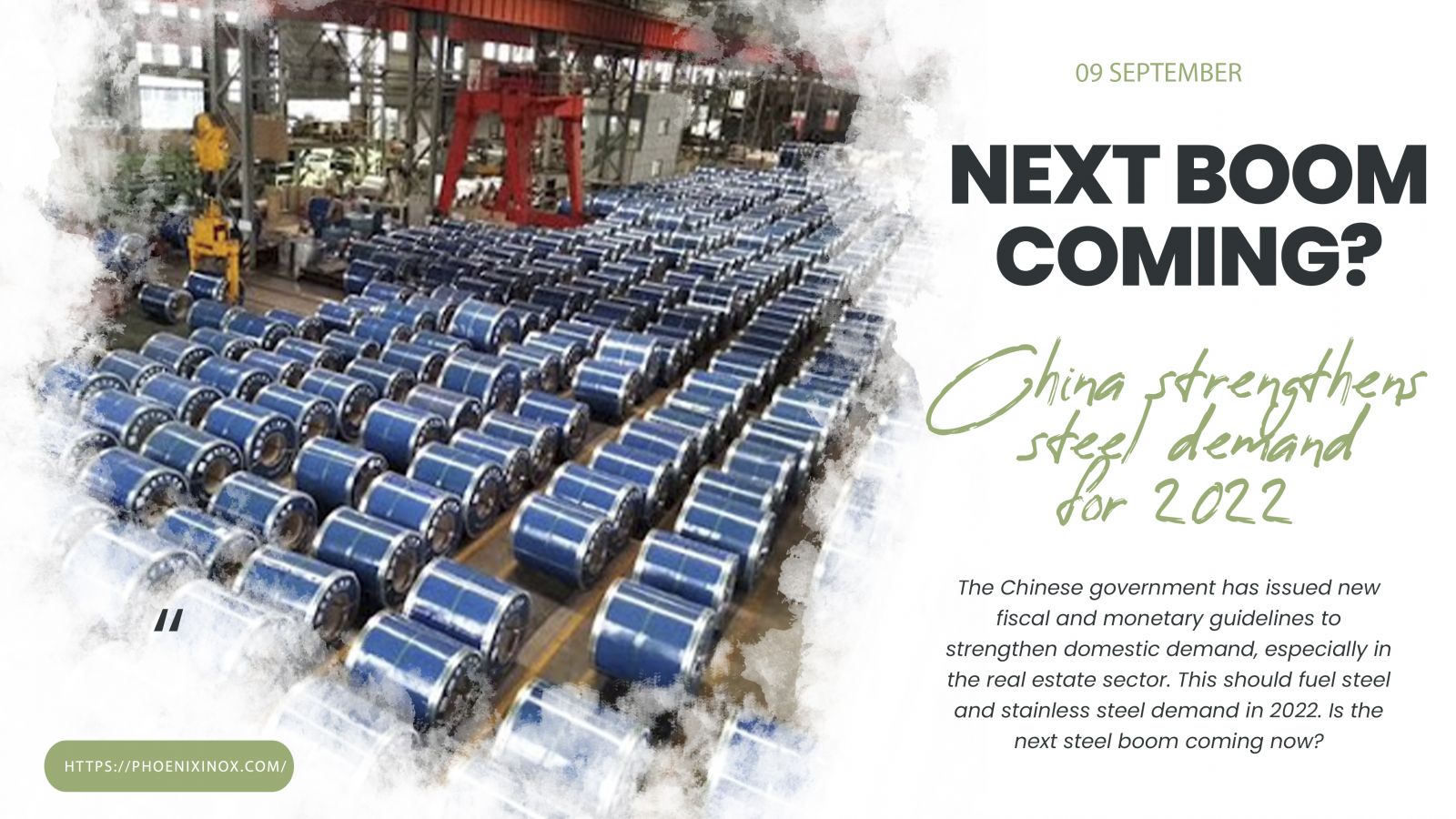China strengthens steel demand for 2022 – Is the next boom coming now?
The Chinese government has issued new fiscal and monetary guidelines to strengthen domestic demand, especially in the real estate sector. This should fuel steel and stainless steel demand in 2022. Is the next steel boom coming now? EU Carbon Border Tax faces growing criticism. SHFE Base Metals majority up. Stainless steel prices down slightly due to seasonal factors – take chances now.

China boosts steel demand for 2022- Is the next boom coming now?
The Chinese government wants to achieve stable economic growth for 2022. To achieve this, the Politburo announced new proactive fiscal and monetary guidelines on 6 December 2021. And the Chinese central bank lowered the reserve requirement ratios of large banks by 0.5 percentage points and those of small and rural banks by 0.25 percentage points on 6 and 7 December.
Chinese real estate sector in focus
The Chinese real estate sector is the largest steel consumer in China, consuming about 30% of annual steel output. In 2021, this sector had suffered and was in slight distress – as shown e.g. by the Evergrande crisis.
With the lowering of reserve requirement ratios and the introduction of new financial guidelines, the central government is now strengthening the consumer in order to boost demand in the real estate sector.
This measure should then lead to stronger domestic steel and stainless steel demand in 2022.
But what is the steel supply side doing?
The Politburo meeting has mainly brought new measures that are of interest to consumers. But new measures on the supply side are missing. Does this point to an easing of Chinese production restrictions?
China wants to reduce steel overproduction and CO2 emissions
China’s declared goal is to significantly reduce the emission of climate-damaging gases and the overproduction of steel. To this end, laws and guidelines have already been put in place in 2021 to shut down old steel plants and encourage the construction of new plants with lower production volumes and cleaner production.
Chinese energy shortage not yet gone
China is suffering from a persistent energy shortage. Among other things, this has been triggered by a lack of rain, a related drought and thus a drop in energy production from hydropower. Although coal prices have been capped, which has reduced costs for energy producers, this only accounts for part of China’s problems.
The aluminium and steel and raw materials industries are among the biggest energy consumers in China. All three industries are operating at reduced capacities. Should the Chinese government relax too much too quickly, the country could quickly find itself facing the next crisis.
Steel producers should not exceed 2020 output levels
Chinese steelmakers have already had to cut back production in 2021 to cope with overproduction, energy shortages and a reduction in CO2 emissions and pollution.
Until at least March 2022, the Chinese government has imposed further production restrictions in the heavy industry. production restrictions in heavy industry and steel production to ensure air quality for the Winter Olympics.
Chinese steel producers must first make up for this shortfall in production. At the same time, the government is strengthening domestic demand from the real estate sector with its new financial guidelines.
Demand for steel, aluminium and raw materials will increase
With the outcome of the COP26 climate summit, rapidly increasing demand for EV raw materials, growing demand for steel, stainless steel and aluminium in the sustainable energy industry, and a shortage in base metals and a government-fuelled increase in demand on the consumer side in China, the global economy is facing entirely new challenges after the Corona pandemic.
This is likely to keep demand and prices up in 2022.
EU Carbon Border Tax faces growing criticism
The European Carbon Border Tax CBAM is facing growing criticism and justified concerns. Already a few days ago, INTA, the European Committee on International Trade, took a critical stance on CBAM and noted that the European Commission’s draft in its current form was more of a market protection measure and would have to be improved in order to be WTO-compliant.
Poorer countries disadvantaged by CBAM
In a recent article, Deutsche Welle also took a critical look at the EU Carbon Border Tax and reported that developing countries in particular would suffer from CBAM. There is also the risk of new trade wars.
SHFE Base Metals up
Base metals on the SHFE are up for the most part today. Nickel is up about 1.14%. For aluminium, up 0.61%. Lead is up 1.88%, Zinc up 1.42% and Tin up 1.15%. Copper barely moves, but holds up.
Stainless steel prices down slightly due to seasonal factors – take chances now
If you look at Chinese stainless steel prices in recent years, you can see that there is always a seasonal trend towards slightly lower prices at the end of the year. Demand from the West also often decreases shortly before Christmas. So people still want to exchange steel for money. This is a good moment to make purchases before prices start to rise again at the beginning of 2022, partly due to the Chinese New Year.
Source: https://steelnews.biz/next-boom-coming-china-strengthens-steel-demand-2022/








